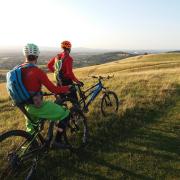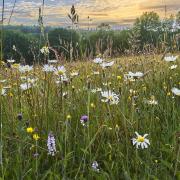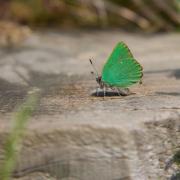When I was researching my book Gloucestershire Folk Tales, I came across many bits and pieces of folklore that had the potential for a good story but needed a bit of work to shape them into tales that would be entertaining on the page or told to a live audience. This often involved some embroidery, and sometimes the solution was to stitch a couple of stories together. That’s what happened with ‘The Snow Foresters’ Mist-Gate’.
This story began with two separate tales, both collected by the folklorist Ruth Tongue and both originating, so she said, from the Cotswolds. One, ‘The Snow Foresters’, is included in Katharine Briggs’s The Folklore of the Cotswolds. The other, ‘The Farys’ Mist-Gate’, appears in Tongue’s Forgotten Folk-Tales of the English Counties.
‘Fary’ – ‘far-y’ – is a local pronunciation of ‘fairy’. ‘Forester’ is a euphemism for ‘fairy’, too, in this case a species of fairies that come out during snowstorms and seem not unlike ghosts. In ‘The Snow Foresters’, a family of Gypsies in their caravan get caught in a snowstorm beside a wood haunted by snow foresters. In ‘The Farys’ Mist-Gate’, a family’s baby daughter is stolen by the fairies and taken through the mist-gate into a fairy hill. Both tales take place on Christmas Eve; in both of them a young son of the family is the protagonist; in both a white cat saves the day after the boy speaks to her in rhyme, because if you talk to a cat in rhyme on Christmas Eve it might talk back; and in both cases the characters find safety when the Christmas church bells ring. Each tale was quite slight on its own, but I realised that, with these common elements, they’d neatly join together to make a very pleasing story.

Briggs identifies the wood where the snow foresters besiege the Gypsy caravan as Idbury Wood, just off the main road (A424) from Burford to Stow-on-the-Wold. When pursuing Gloucestershire’s old tales through the landscape, I repeatedly read about trackless wild woods but then found on the ground only small scraps of woodland still extant in the places in question. In the case of ‘The Snow Foresters’, my partner Kirsty and I found a tiny triangle of woodland opposite some old earthworks. Peering among the trees, their trunks overgrown with ivy, I tried in my mind’s eye to expand this little habitat into more extensive woodland. It’s here during the snowstorm that the white cat slips into the caravan, and here too, in my composite story, that the snow foresters steal the baby when an icy gust of wind slams open the caravan door.

The cat guides the baby’s brother to the road, where he gains the further allies of the parson’s donkey, who’s strayed during the storm from St Edward’s Church in Stow, and the church ‘grim’, a spectral black dog from the church who’s come in search of the donkey. This canine is not to be confused with the malevolent black dogs that feature in many English folktales. He’s a benign spirit being who normally guards the churchyard and is able to provide the boy with advice and assistance supplementing the cryptic wisdom proffered by the cat. The grim has the spiritual power to hold open the mist-gate of the fairy hill while the boy, seated upon the holy cross on the donkey’s back, ventures within to rescue his baby sister.

Tongue doesn’t identify the fairy hill in question, but the only such hill that fits the story is the tumulus of Wyck Beacon, just off the A424, half a mile north of Upper Rissington and en route to Stow, where the story ends. This hill, like many fairy hills, is a prehistoric (probably Bronze Age) round barrow. You can view it from the Oxfordshire Way running along a lane immediately to its west. Rising from the barrow’s summit are three shapely beech trees, which you can well imagine turning into dancing green ladies on moonlit nights, as in Tongue’s Derbyshire tale of The Green Ladies of One Tree Hill. Around its base are hawthorn trees, amidst which you can picture the mist-gate as a shimmering mandorla – the eye-like shape of the overlap of two intersecting circles representing the two worlds – through which the boy enters the fairies’ otherworld. This world within the hill opens out vastly bigger than seems possible from the outside. The temptation, as in many stories of fairyland, is to forget why you went there, to linger and explore and maybe never come back. Fortunately, the boy is sitting on the donkey’s cross and has the grim to galvanise him to grab his shivering little sister and get out before the mist-gate closes.
Once the team re-emerge into the snowstorm, the snow foresters spot them. The white cat, who’s been waiting on guard, leaps up and bites the donkey’s tail to propel the beast to get moving. With the boy and baby on the donkey’s back, the cat still clinging to the tail, and the grim romping alongside, they flee at the gallop, the snow foresters’ icy breath howling behind them, till they reach the church in Stow. There the boy takes his sister into the porch, framed by two yew trees melded with the stonework, which some say inspired Tolkien’s Door of Durin in The Lord of the Rings. When the grim then rings the Christmas bells, the snow foresters go screaming back through the mist-gate to escape the torment of that Christian sound.
When the boy and baby are reunited with the rest of the family, the cat is found to have disappeared. The granny concludes that the cat must have been a fallen angel trying to work her way back to heaven one good deed at a time. There seems to be an allusion here to the wider notion that the fairies are angels who fell from heaven but, instead of falling all the way to hell, as the devils did, fell only to the middle level of the cosmos. The implication is that the white cat, too, is a fairy.
As it happens, it was December when we toured the locations of this story. There was snow on the ground and you could readily imagine there’d been a snowstorm the night before. In Stow, we saw huge pillars of snow, like the remains of giant snowmen – or perhaps of snow foresters who’d failed to get back through the mist-gate before it closed. It was a reminder, at least, that Stow sits at quite a high altitude.
With its young hero, its team of animal characters, and the evocative settings of snowstorm, Gypsy caravan, fairyland, and Christmas village, I reckon this composite story has the makings of a Disney animated musical. I can even imagine the songs: a Gypsy knees-up at the start; the shivery song of the snow foresters; a rhyming duet of boy and cat; the comedy duet of donkey and grim; the hit single of the boy tempted by fairyland (and its queen?); the snow foresters’ reprise; and a Christmas carol with soaring church bells. Disney’s recent films of that ilk have ranged between Scotland, Scandinavia, Polynesia, Africa, Indochina, and Colombia. It’s high time for the Cotswolds! I’m just waiting for Disney to option the story.
COMPASS POINTS
Parking: The roadside for Idbury Wood and Wyck Beacon. Car parks on the Fosseway and Maugersbury Road in Stow.
Toilets and refreshments: Numerous pubs, cafes, and restaurants in Stow.
Further reading: Gloucestershire Folk Tales by Anthony Nanson. Forgotten Folk-Tales of the English Counties by Ruth Tongue. The Folklore of the Cotswolds by Katharine Briggs.
Anthony Nanson is based in Stroud and available as a storyteller and speaker. His books include, among others, Gloucestershire Folk Tales and (with Kirsty Hartsiotis) Gloucestershire Ghost Tales and Gloucestershire Folk Tales for Children. Anthony also runs the small press Awen Publications.



























